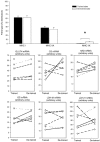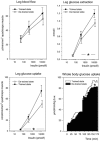Resistance training and insulin action in humans: effects of de-training
- PMID: 12897182
- PMCID: PMC2343294
- DOI: 10.1113/jphysiol.2003.043554
Resistance training and insulin action in humans: effects of de-training
Abstract
Aerobic endurance training increases insulin action in skeletal muscle, but the effect of resistance training has not been well described. Controversy exists about whether the effect of resistance training is merely due to an increase in muscle mass. We studied the effect of cessation of resistance training in young, healthy subjects by taking muscle biopsies and measuring insulin-mediated whole body and leg glucose uptake rates after 90 days of heavy resistance training (T) and again after 90 days of de-training (dT). Data on leg glucose uptake were expressed relative to accurate measures of leg muscle mass by MRI scanning. Muscle strength (239 +/- 43 vs. 208 +/- 33 N m), quadriceps area (8463 +/- 453 vs. 7763 +/- 329 mm2) and glycogen content (458 +/- 22 vs. 400 +/- 26 mmol (kg dry weight muscle)(-1)) decreased, while myosin heavy chain isoform IIX increased 4-fold in dT vs. T, respectively (all P < 0.05). GLUT4 mRNA levels and enzyme activities and mRNA levels of glycolytic, lipolytic and glyconeogenic enzymes did not change with de-training. Likewise, capillary density did not change. Whole body glucose uptake decreased 11 % and leg glucose uptake decreased from 75 +/- 11 (T) to 50 +/- 6 (dT) nmol min(-1) (mm muscle)(-2) (P < 0.05) at maximal insulin, the latter decrease being due to decreased arterio-femoral venous glucose extraction. The decrease was mainly due to reduced non-oxidative glucose disposal. We have thus shown that 90 days after the termination of heavy resistance training, insulin-mediated glucose uptake rates per unit of skeletal muscle have decreased significantly.
Figures




References
-
- Andersen JL, Aagaard P. Myosin heavy chain IIX overshoot in human skeletal muscle. Muscle Nerve. 2000;23:1095–1104. - PubMed
-
- Chomczynski P, Sacchi N. Single-step method of RNA isolation by acid guanidinium thiocyanate-phenol-chloroform extraction. Anal Biochem. 1987;162:156–159. - PubMed
-
- Craig BW, Everhart J, Brown R. The influence of high-resistance training on glucose tolerance in young and elderly subjects. Mech Ageing Develop. 1989;49:147–157. - PubMed
-
- Dela F. On the influence of physical training on glucose homeostasis. Acta Physiol Scand. 1996;158:5–41. - PubMed
-
- Dela F, Larsen JJ, Mikines KJ, Galbo H. Normal effect of insulin to stimulate leg blood flow in NIDDM. Diabetes. 1995;44:221–226. - PubMed
Publication types
MeSH terms
Substances
LinkOut - more resources
Full Text Sources
Medical
Miscellaneous

